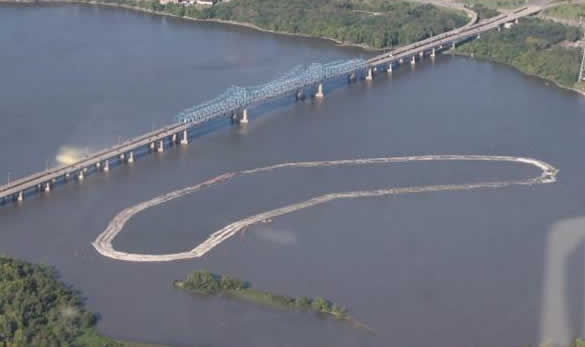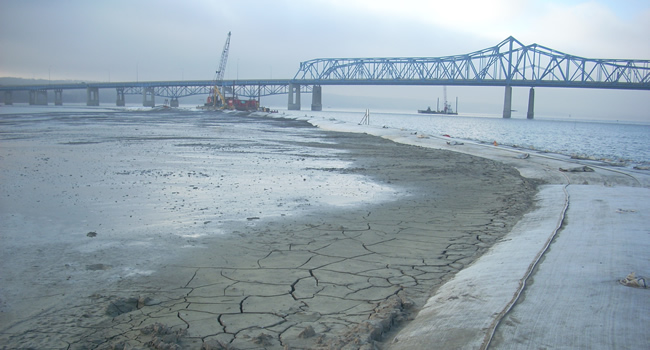Duke University’s Center on Globalization, Governance, & Competitiveness (CGGC) published a 44-page report in 2012 on coastal restoration projects and how geosynthetic technologies were playing a greater role. Funded by the Environmental Defense Fund and the Walton Family Foundation, the report, “Geosynthetics: Coastal Management Applications in the Gulf of Mexico,” highlighted technologies such as geotextile tubes and oil booms.
Geosynthetic materials were certainly on display in the Gulf following the BP oil spill. While the CGGC’s publication followed closely on the heels of the Gulf spill and the need to address habitat survivability (e.g., through RESTORE Act funding), the report’s emphasis on the larger issue of restoration stands out.

Today, habitat creation and restoration is an expanding, active sector of engineering and environmental protection. Mitigation banks are helping to spur the creation of new habitats in coastal and inland environments. These endeavors offset the loss of habitat elsewhere. The engineering solutions cited in CGGC’s report are a major part of these works.
HABITAT CREATION WITH MITIGATION BANKS
It is fitting that the Walton Family Fund helped fund the production of CGGC’s report. The fund was established by the Waltons of Walmart fame. The massive expansion of big box stores has presented a number of environmental challenges to communities.
Commercial and residential developments are frequently linked. The environmental pressures these developments produce include the need to expand roadways, carve up and build upon agricultural and undeveloped natural tracts of land, and manage far more stormwater challenges.
Two decades of strong growth in housing and commercial real estate have been accompanied by a rapid rise in fines for construction-related sediment runoff.
Best practices and stronger sediment controls could be implanted to blunt the impact of runoff, but the larger issue of habitat loss due to construction could not.
Mitigation banks, thus, became more important.
The 2013 National Mitigation and Ecosystem Banking Conference (May 7 – 10) brings the discussion to what has been the epicenter for many of the habitat protection arguments: New Orleans, Louisiana.
Mitigation banking essentially combines investment and responsible environmental management. If one develops 10 acres of land here for commercial real estate, 10 acres that may have been wetlands or some other habitat-supporting zone have been removed. But, if you can create or restore 10 acres of habitat elsewhere, you have at least on paper an even trade between economic prosperity in one location and environmental security in another.

It isn’t that simple, really, but that’s the general premise. It creates a market for mitigation credits, much as carbon credits might be traded in some markets. Unlike carbon credit trading, however, mitigation banking allows for the creation of what is essentially a cleaner, more sustainable habitat. The 10 acres of habitat you create will need to be engineered in strict accordance to environmental guidelines to ensure the diversity and safety of plant and animal species. That gives mitigation banking an opportunity to create a habitat that is more diverse and successful than the abandoned farmland or sediment-laden stream being rehabilitated.
Also, depending on local or state rules, mitigation offset requirements can actually be used to create even more habitat. The generic example above proposes an even 10 for 10 acres exchange. But a state agency might just as well require a 2:1 or 5:1 or even 20:1 exchange (new habitat to new development) to create more thriving habitat zones.
This type of code can be used to curtail development for environmental or economic reasons. Perhaps infrastructure development has fallen too far behind. Perhaps a land bubble is feared. Either way, mitigation banking can provide a powerful tool for sustainable development because profit potential (defined as financial and environmental gains) is used as a weight on both sides of the exchange.
Getting to that profit takes time. Habitat needs time. The process requires land protection strategies and years of monitoring, including the need for strategies to protect trees from some of the very species for which you are improving a habitat.
PROTECTING TREES
Protecting trees in a habitat-sustaining manner, such as those utilized in mitigation bank-funded projects, is not simple, especially on the scale tree health needs to be cultivated in habitat renewal projects.

Game will eat seedlings, which can undermine the development of game-supporting habitat. Abandoned farm fields are often seen as prime lands for restoration, but these fields are also prime ground for mice and field moles, both of which can be highly destructive to the creation of diverse habitats.
As such, when forestation is part of habitat creation, a strong emphasis needs to be placed on making sure those trees and affiliated plants can take root and grow free of disease or failure-causing interference. How you protect those plants in the early stages of development will largely determine the success of a site.
Tree shelters are critical. These solutions are positioned around a young tree and allow the tree to grow, in its earliest phases, up through the shelter. Constructions vary. Home gardeners might use scrap, like chicken wire or snow fence or black tubing cut from garden supplies. On larger sites with greater plant life to protect, such as on a 2- or 5-acre habitat-creating plot for a mitigation investment or corporate campus, something a little more engineered is required.
One such product is Tubex from Tennessee-based Berry Global. The solid tube units protect seedlings and young trees by allowing high air moisture and more secure water management (including in drought) while shielding the seedlings from hungry game such as deer.
Tubes like this are available in standard product sizes up to approximately 5 ft, which allows for significant years of protection. Some products are manufactured with a laser-perforated edge, which means the tube will split as the tree grows to a more self-preserving thickness. The trunk can expand outwards and the shelter will begin to yield. Land managers can then remove these units easily as the site’s trees reach a secure stage of maturity.
Tree shelters are being used in more than mitigation banking-related projects. Viticulture, for example, provides an interesting market. As vineyards expand, grape growers want to protect their investment. Tree shelters provide that security.
Still, mitigation banking drives much of the trend, especially with the influence and guidance of the US Army Corp of Engineers, United States Department of Agriculture, and other government agencies paying close attention to mitigation activities. They have helped put in place assurances to improve success rates for habitat development. That’s an attractive proposition for investors. As such, professional mitigation banks have gone from single digits in their earliest days in the 1980s to hundreds of groups and opportunities today.
The USDA and many other government agencies have contributed to cost-share programs in the mitigation banking sector to encourage the development of both lands and technical expertise.
WANT TO KNOW MORE? Consult a local or regional USDA office to learn about potential cost-share strategies or to learn about types of development, such as banks for emerging (more herbaceous) wetlands and forested wetlands.
ISLANDS IN THE STREAM
It’s long been said that investing in land is smart because “they aren’t making more of it.” In general, this is true. Mitigation strategies are creating more habitat, but not more land—except in the case of artificial islands.
The US Army Corps of Engineers (Rock Island District, Illinois) has embarked on the creation of a 21-acre island to restore a deep water fisheries habitat in Lower Peoria Lake. This is part of the Illinois Waterway and adjacent to an important navigation channel.

The on-going project is slated for completion by mid-2013. The design involves a ring of geotextile tubes, which were used to establish the island’s 4,800-ft perimeter, subsequently creating a bermed disposal area for backfilling with dredged soils. This creates deeper water that is beneficial to fish and navigation, and the dredged spoils, contained behind the geosynthetic tubes, become soil in which a new vegetative wetland habitat emerges.
Maccaferri’s MacTube® geotextile containers have been used to provide structural integrity to the designed island system. Three rows of tubes on the base with a fourth on top have been installed and each tube has been filled to a height of six feet with dredged river soils.
The soils, excavated from 5,700 linear feet of channel, were screened and mixed with water to create a strong slurry that, when pumped into the containers, stabilized the island’s edge.
Midwest Foundation Corporation has served as the general contractor.
Artificial island creation has received some significant attention in recent years, but largely because of boutique island developments in the United Arab Emirates. There, some truly extraordinary engineering is taking place to create private islands with high-end real estate. The resulting islands come with a Vegas-like visual impact, such as a network of islands in the shape of a palm leaf or the shape of the world’s land masses.
Habitat creation is seldom profiled in regards to artificial islands, but these highly effective and attainable environmental management designs achieve habitat creation goals and offer additional benefits, such as safer and more usable waterways. In some contexts, they help strike a balance between commercial (e.g., navigation) and environmental (e.g., habitat) interests.


In Peoria, once the stable ring of geotextile tubes was established, additional spoils were filled in behind it. Vegetation took hold quickly and an upland habitat was created for nesting birds, snakes, and other wildlife.
This island may not come with a flashy development name or private residence, but it is a beautiful piece of engineering and it is creating and restoring something we must not neglect.
ACKNOWLEDGEMENTS
We thank Jeff Brower for sharing his insight into mitigation banking and tree shelters for habitat protection and growth. Also, Jenna Phillips provided technical insight into the creation of the island in Peoria and the use of geocontainers in this type of application.











